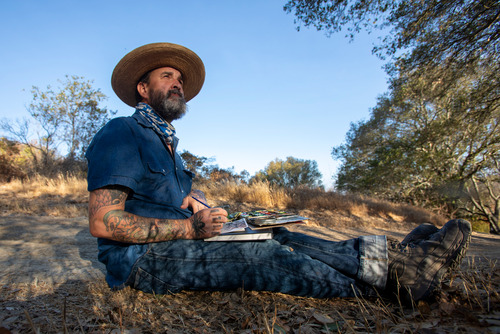
In the final installment of his trilogy of books about California’s landscape, Obi Kaufmann tackles terrain that’s far more diverse and lively than most Californians realize.
“The Deserts of California: A California Field Atlas,” out this month from Heyday, takes readers from the Salton Sea to Mono Lake and beyond in an exploration of the eastern side of the state. Along the way, you’ll learn about plants endemic to the San Bernardino Mountains; the endangered California bighorn sheep of the Sierra Nevada; and the resilient pupfish populations found in spots like the Death Valley basin and Amargosa River.
Related: Sign up for our free Book Pages newsletter about bestsellers, authors and more
Kaufmann, who published “The Forests of California” in 2020 and “The Coasts of California” last year, opens the more than 500-page book with the proclamation, “This is an adventure story.”
“That adventure is a call to understanding,” explains the Oakland-based artist and author on a recent phone call, “ultimately, how to then identify with being from California or, in this case, the California deserts.”
Mighty atlas
Kaufmann developed a format called the “field atlas,” which he first used for his 2017 tome, “The California Field Atlas,” and throughout the “California Lands” trilogy. Kaufmann merges information with art and insight to present a handbook that explains the elements of a landscape, how the elements interact and what the future of the landscape may hold.
Filled with enchanting watercolors and detailed descriptions, Kaufmann’s field atlases can stoke an urge to explore California’s landscapes up close. That’s particularly apparent in “The Deserts of California,” where so many of the details are hiding in plain sight.
“When you’re walking, the desert opens up with a biodiversity,” Kaufmann adds. “We see biodiversity that is extensive, robust and resilient despite what is happening in the 21st century.”
“In all of my work, all of these books, there is a pervasive ethic that is pedestrian,” says Kaufmann. “Walking the ecology of the landscape.”
While “The Deserts of California” can be a very useful resource, it’s not a textbook, Kaufmann explains.
“It aims to present a larger perspective that’s tied to a human understanding of what ecology actually means, not just what it is,” he says. “In that regard, this book becomes a prayer or a meditation on biodiversity, these vectors of resilience that must be reinforced and defended as we proceed through this bottleneck represented by so many challenges.”
Changes and challenges
Climate change — Kaufmann refers to the phenomenon as “climate breakdown” — is the most crucial challenge across the globe, particularly in the deserts, he says. But “The Deserts of California,” like Kaufmann’s other work, is imbued with a hopefulness: What if the future is less bleak than anticipated?
“We are looking at a system evolving across a human community and a natural community that may in fact lead to the surprising conclusion at the end of the century that the desert is in fact in a stronger position at the end of the 21st century than it was at the end of the 20th century,” he says.
In “The Deserts of California,” Kaufmann also carefully considers the impact of human intervention and public policy has had on the land. In the process, he highlights even the unintended consequences of the actions taken out of a love of the desert.
“There seems to be a lot of paradoxes that become apparent when you talk about conservation in the desert,” says Kaufmann. Those paradoxes come into play when talking about renewable energy (“The desert is doing so much work for California’s plan to become post-carbon by 2045,” says Kaufmann) and designated conservation areas, as well as population growth in the desert areas.
“The incredible rise of residential development across the Mojave, for example, is occurring because people love the desert, but that development also wounds the desert,” says Kaufmann. “Is love for the desert wounding the desert? This is another paradox that needs to be confronted.”
Fire next time
Currently, Kaufmann is working on his fifth book, “The State of Fire: Understanding How, Where and Why California Burns,” which is slated for publication in 2024.
“It’s ironic that my two worlds have come together now with the York fire in the New York Mountains of Mojave National Preserve,” says Kaufmann. “The deserts have hosted the largest wildland fire in California this year so far.”
Through his work, Kaufmann is looking at what it means for people to be part of California. “I’m fascinated by policy and the democratic process across the state and the country and the world and my perspective is of a citizen,” says Kaufmann.
“Ultimately, to that end, I really want — I suppose this is a core belief — to find out how to be more from this place,” he adds. “How do I disarm the colonist? How do I disarm the expert in my own mind and invite my audience on this journey with me to explore these ecological laws, these ecological truths across the landscape so that we can better understand how they bend in order that they don’t break.”
Related Articles
The Book Pages: Wimpy Kid’s ‘No Brainer’ library support tour is coming
This week’s bestsellers at Southern California’s independent bookstores
How Ben Caldwell and Robeson Taj Frazier’s ‘KAOS Theory’ project came to be
Lynsi Snyder’s In-N-Out book gives an inside, top-down and ground-up history of the burger chain
‘Hitchcock’s Blondes’ explores the director’s films with Grace Kelly, Ingrid Bergman, more
